Home Site Map - Steps - Basement Walls and Ceiling -
Batons, Doors, Windows
Buy windows and doors
Details on selecting windows can be found here and info on doors is here .
Purchase the quantity that you need for the basement.

Prepare window openings
Remove sliding window bucking and remake
Remove the sliding window bucking. It may be necessary to cut the bottom sill with a circular saw because of concrete through the fill holes.



The details of the window bucking design can be found here . In the diagram below, the join between the removable part of the bucking and the bits that stay in place is signified by the red line. The blue line shows the waterproof membrane (which stays in place).
Remake the sliding bucking as needed. Replacing the bottom sill is the only essential section to replace because it has concrete fill holes in it.
The sides need a 0.5"-0.5" 45 degree bevel on the inside edge. The edge of the drywall will attach to the 45 degree bevel.




Cut away EPS and lumber at 45 degrees
As can be seen in the diagram below, it is necessary to cut away the polystyrene and the lumber in the window opening to form a 45 degree angle on the left and right. This is to increase the angle of view out through the windows given that the walls are so thick. The cutting is not done at the top and bottom of the window openings (only at the left and right sides).

The reference point for the 45 degree cut is the corner of the set concrete. Nearly half the width of the 8" wide 2-bys that slot into the ICF cavity will get cut away. The cut can be a little rough because it will eventually be covered up by drywall.

Fit sliding bucking
It goes back into the window hole. but is fitted with a 3.5" back from the edge of the in-cavity bucking. This means it will protrude by 3-3/8" beyond the outside face of the ICF EPS.








Repair ICF EPS around window area



Waterproof sliding bucking protrusion
Use 12" wide strips of Grace Ice and Water to waterproof top bottom and sides of the protrusion. Do the bottom strip first and the top strip last. The first 1.5" is the surface that the window seats on and it finishes with 4" stuck onto the outside wall ICF EPS.
At the corners where the straight pieces of Grace Ice and Water meet, fit pieces of flexible wrap over the top. Details of the flexible flashing for the corners is here .

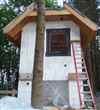
Fit windows

Windows are very heavy, so you will want to rig up a rope and pulley system to the top two corners.











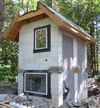
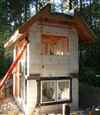


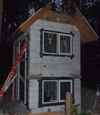



Add flashing over window nail flange
This is an additional layer of flashing on the outside over the window nailing flange once the window has been fitted. Conventional window says there should not be and flashing along the bottom of the window so that water can drip out. However this does not make sense in the context of an air tight house. You will want flashing along the bottom and it need to be applied before flashing the sides. The flashing along the top of the window is done last.

As a final step, on the corners add some flexible self-stick gasket...

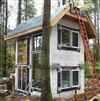
Install exterior doors
Make and install garage door




